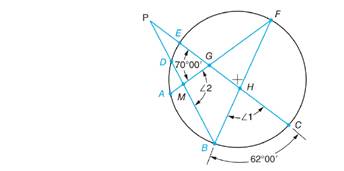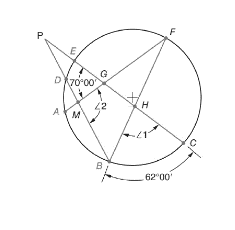
Concept explainers
Solve the following exercises based on Principles 18 through 21, although an exercise may require the application of two or more of any of the principles. Where necessary, round linear answers in inches to 3 decimal places and millimeters to 2 decimal places. Round angular answers in decimal degrees to 2 decimal places and degrees and minutes to the nearest minute.
a. If ∠ 1 = 67°00' and ∠ 2 =93°00', find:
(1)
(2)
b.If ∠ 1 = 75°00' and ∠ 2 =85°00', find:
(1)
(2)

(a)
The value of arc
Answer to Problem 26A
The values of arcs AB and DE are
Explanation of Solution
Given information:
The value of angle 1 is
The value of angle 2 is
The given figure is

Calculation:
The angles GHF and angle 1 are opposite angles. Thus,
Similarly, the angles EGM and angle FGH are opposite angles.
In triangle FGH, the angle GFH comes out to be
Now, an inscribed angle is one half the value of intercepted arc by the angle itself.
The line PMB is a straight line so,
Now, in triangle PMG, the sum of all angles should be equal to 180o.
Now, the value of arc DE can be found from the following formula,
The values of arcs AB and DE are
Conclusion:
Thus, the values of arcs AB and DE are
(b)
The value of arc
Answer to Problem 26A
The values of arcs AB and DE are
Explanation of Solution
Given information:
The value of angle 1 is
The value of angle 2 is
The given figure is

Calculation:
The angles GHF and angle 1 are opposite angles. Thus,
Similarly, the angles EGM and angle FGH are opposite angles.
In triangle FGH, the angle GFH comes out to be
Now, an inscribed angle is one half the value of intercepted arc by the angle itself.
The line PMB is a straight line so,
Now, in triangle PMG, the sum of all angles should be equal to 180o.
Now, the value of arc DE can be found from the following formula,
The values of arcs AB and DE are
Conclusion:
Thus, the values of arcs AB and DE are
Want to see more full solutions like this?
Chapter 54 Solutions
EBK MATHEMATICS FOR MACHINE TECHNOLOGY
- Determine whether each function is an injection and determine whether each is a surjection.arrow_forwardLet A = {a, b, c, d}, B = {a,b,c}, and C = {s, t, u,v}. Draw an arrow diagram of a function for each of the following descriptions. If no such function exists, briefly explain why. (a) A function f : AC whose range is the set C. (b) A function g: BC whose range is the set C. (c) A function g: BC that is injective. (d) A function j : A → C that is not bijective.arrow_forwardLet f:R->R be defined by f(x)=x^(3)+5.(a) Determine if f is injective. why?(b) Determine if f is surjective. why?(c) Based upon (a) and (b), is f bijective? why?arrow_forward
- Let f:R->R be defined by f(x)=x^(3)+5.(a) Determine if f is injective.(b) Determine if f is surjective. (c) Based upon (a) and (b), is f bijective?arrow_forward1 S 0 sin(lnx) x² - 1 Inx dxarrow_forward2 6. Modelling. Suppose that we have two tanks (A and B) between which a mixture of brine flows. Tank A contains 200 liters of water in which 50 kilograms of salt has been dissolved and Tank B contains 100 liters of pure water. Water containing 1kg of salt per liter is pumped into Tank A at the rate of 5 liters per minute. Brine mixture is pumped into Tank A from Tank B at the rate of 3 liters per minute and brine mixture is pumped from Tank A into Tank B at the rate of 8 liters per minute. Brine is drained from Tank B at a rate of 5 liters per minute. (a) Draw and carefully label a picture of the situation, including both tanks and the flow of brine between them. JankA 1ks of Salt Slits Pump EL Brine mit tark A from tank 13 Tank 13 k 3L zooliters of Ico liters of water with pure water. Saky salt → 777 disslore inside Brine mix is pumped from tank A to B of 82 Brine drainen min by Gf salt (b) Assume all brine mixtures are well-stirred. If we let t be the time in minutes, let x(t) 1ks…arrow_forward
- No chatgpt plsarrow_forwardRemix 4. Direction Fields/Phase Portraits. Use the given direction fields to plot solution curves to each of the given initial value problems. (a) x = x+2y 1111 y = -3x+y with x(0) = 1, y(0) = -1 (b) Consider the initial value problem corresponding to the given phase portrait. x = y y' = 3x + 2y Draw two "straight line solutions" passing through (0,0) (c) Make guesses for the equations of the straight line solutions: y = ax.arrow_forwardIt was homeworkarrow_forward
 Elementary Geometry For College Students, 7eGeometryISBN:9781337614085Author:Alexander, Daniel C.; Koeberlein, Geralyn M.Publisher:Cengage,
Elementary Geometry For College Students, 7eGeometryISBN:9781337614085Author:Alexander, Daniel C.; Koeberlein, Geralyn M.Publisher:Cengage, Elementary Geometry for College StudentsGeometryISBN:9781285195698Author:Daniel C. Alexander, Geralyn M. KoeberleinPublisher:Cengage Learning
Elementary Geometry for College StudentsGeometryISBN:9781285195698Author:Daniel C. Alexander, Geralyn M. KoeberleinPublisher:Cengage Learning Mathematics For Machine TechnologyAdvanced MathISBN:9781337798310Author:Peterson, John.Publisher:Cengage Learning,
Mathematics For Machine TechnologyAdvanced MathISBN:9781337798310Author:Peterson, John.Publisher:Cengage Learning, Trigonometry (MindTap Course List)TrigonometryISBN:9781337278461Author:Ron LarsonPublisher:Cengage LearningAlgebra & Trigonometry with Analytic GeometryAlgebraISBN:9781133382119Author:SwokowskiPublisher:Cengage
Trigonometry (MindTap Course List)TrigonometryISBN:9781337278461Author:Ron LarsonPublisher:Cengage LearningAlgebra & Trigonometry with Analytic GeometryAlgebraISBN:9781133382119Author:SwokowskiPublisher:Cengage




